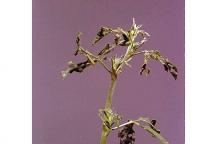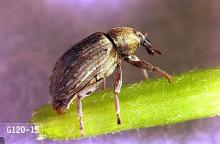Hypera postica
Pest description and crop damage Larvae are about 0.375 inch long, yellow to green, with a white stripe down the back. They feed in and on the buds and leaves of alfalfa. For additional information on their biology and management, see: https://extension.usu.edu/crops/research/alfalfa-weevil .
Sampling and thresholds
Treat when-
- Thirty percent of plant terminals show feeding damage. Either cut and then treat stubble or treat the standing crop, depending on how close to cutting it is.
- Damage is noticeable 1 week or more before estimated cutting time, and larvae exceed 10 per 90° sweep, sometimes called a straight-line sweep).
- Larvae number 20 or more per sweep (180° sweep, sometimes called a half-circle sweep). Thresholds based on larvae per sweep are a general guideline; weather, plant vigor, irrigation schedules, cutting date, history of weevils in the area, and a complex of other factors should be considered in making treatment decisions.
Management-chemical control
Most of these insecticides are hazardous to bees and should not be applied if bees are actively foraging in the alfalfa.
- alpha-cypermethrin (Fastac EC) at 0.014 to 0.025 lb ai/A. PHI 3 days of cutting or grazing. REI 12 hr. Retreatment interval 7 days. Do not exceed 0.025 lb ai/cutting and 0.075 lb ai/A per season.
- beta-cyfluthrin (Baythroid XL) at 0.0125 to 0.022 lb ai/A. PHI 7 days for grazing or cutting. REI 12 hr. Retreatment interval 5 days. Do not exceed 0.044 lb ai/A per cutting or 0.175 lb ai/A total per season. (Group 3A)
- carbaryl (numerous products) at 1 to 1.5 lb ai/A. PHI 7 days for grazing or cutting. REI 12 hr. If pretreatment damage is extensive, cut alfalfa and treat the stubble for alfalfa weevil larvae. This product is not effective against adult alfalfa weevils. Do not apply more than once per cutting. Carbaryl may burn or yellow hay under some conditions, and applying to wet foliage or during high humidity may injure tender foliage. Latex-based formulations, such as Sevin XLR Plus, are less hazardous to bees. (Group 1A)
- chlorantraniliprole/lambda-cyhalothrin (Besiege) at 0.059 to 0.088 lb ai/A. PHI 1 day for forage and 7 days for hay. REI 24 hr. Minimum of 5 days between applications. Do not exceed 0.12 lb ai of products containing lambda-cyhalothrin or 0.2 lb ai of chlorantraniliprole-containing foliar products per acre per growing season. (Groups 28 and 3A)
- cyfluthrin (Tombstone) at 0.025 to 0.044 lb ai/A. PHI 7 days for grazing or cutting. REI 12 hr. Retreatment interval 5 days. Do not exceed 0.088 lb ai/A per cutting or 0.35 lb ai/A total per season. (Group 3A)
- gamma-cyhalothrin (Declare) at 0.01 to 0.015 lb ai/A. PHI 1 day for forage harvest or 7 days for hay harvest. REI 24 hr. Do not exceed 0.015 lb ai/A per cutting or 0.06 lb ai/A per season. Refer to product labels for application limits if products containing gamma-cyhalothrin and products containing lambda-cyhalothrin are to be used in the same season. This product is highly toxic to bees exposed to direct treatment or residues on blooming crops or weeds. Do not apply this product or allow it to drift to blooming crops if bees are visiting the treatment area. (Group 3A)
- GS-omega/kappa-Hxtx-Hv1a (Spear Biological) at 0.2 to 0.8 lb ai/A. PHI 0 days. REI 4 hr. Do not exceed 2 lb ai/A per year.
- indoxacarb (Steward) at 0.065 to 0.11 lb ai/A. PHI 7 days for cutting. REI 12 hr. Larval control only. Do not exceed one application per cutting or 0.44 lb ai/A total per season. May be applied to alfalfa through overhead sprinkler systems (Group 22A)
- lambda-cyhalothrin (Warrior II) at 0.02 to 0.03 lb ai/A. PHI 1 day for forage harvest or 7 days for hay harvest. REI 24 hr. Apply only to pure stands, avoid applications when bees are actively foraging. Do not exceed 0.03 lb ai/A per cutting or 0.12 lb ai/A per season. Refer to product labels for application limits if products containing gamma-cyhalothrin and products containing lambda-cyhalothrin are to be used in the same season. (Group 3A)
- malathion (numerous products) at 1 to 1.25 lb ai/A. PHI 0 days. REI 12 hr. Larvae only. Not effective below 65°F. Do not exceed 2 applications per cutting and maintain a minimum 14-day interval between applications. (Group 1B)
- methomyl (Lannate LV; other products) at 0.9 lb ai/A. PHI 7 days for grazing or cutting. REI 48 hr. Effective on larvae only. Do not exceed 10 applications per season or 3.6 lb ai/A total in one season. (Group 1A)
- permethrin (numerous products) at 0.1 to 0.2 lb ai/A. PHI 0 days at 0.1 lb ai/A or less, 14 days at more than 0.1 lb ai/A. REI 12 hr. Do not exceed 0.2 lb ai/A per cutting. Retreatment interval 30 days. (Group 3A)
- phosmet (Imidan 70-W) at 0.7 to 1 lb ai/A. PHI 7 days for grazing or cutting. REI 5 days. Do not apply more than once per cutting. Do not apply during bloom. Do not use latex- or pineolene-based adjuvants. (Group 1B)
- spinosad (Entrust SC) at 0.031 to 0.063 lb ai/A. PHI 0 days forage; 3 days hay or fodder. REI 4 hr. Only for suppression of alfalfa weevil larvae. Do not exceed 0.186 lb ai/A per season. Do not exceed 6 applications per season. Entrust is OMRI-listed for organic use. (Group 5)
- zeta-cypermethrin at 0.028 to 0.05 lb ai/A (Mustang), or at 0.014 to 0.025 lb ai/A (Mustang Maxx). PHI 3 days for cutting or grazing, 7 days for harvesting seed. REI 12 hr. Retreatment interval 7 days. Do not use more than 0.1 lb ai/A per cutting or more than 0.3 lb ai/A per season (Mustang) or 0.05 lb ai/A per cutting or 0.15 lb ai/A per season (Mustang Maxx). These products are highly toxic to bees exposed to direct treatment or residues on blooming crops or weeds. Do not apply this product or allow it to drift to blooming crops if bees are visiting the treatment area. (Group 3A)



